A journal set to self-destruct. Topics: magic, revolts, desire, images, political history, films, books I read, poetry, landscapes, and curious artifacts.
Don't wanna be here? Send us removal request.
Text
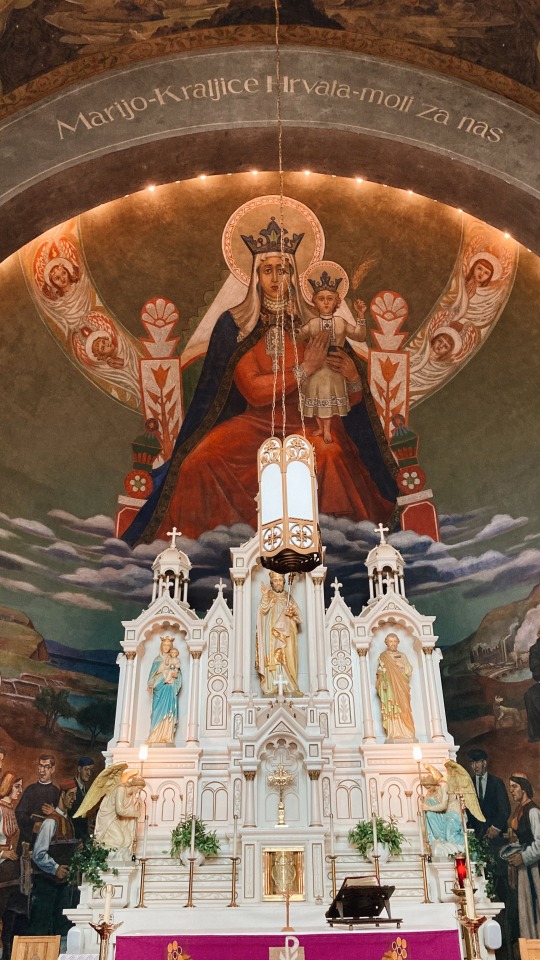
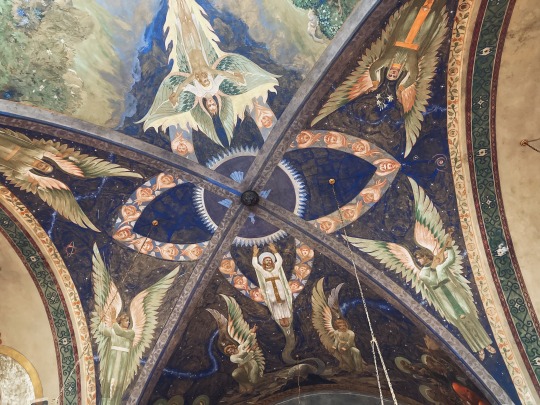
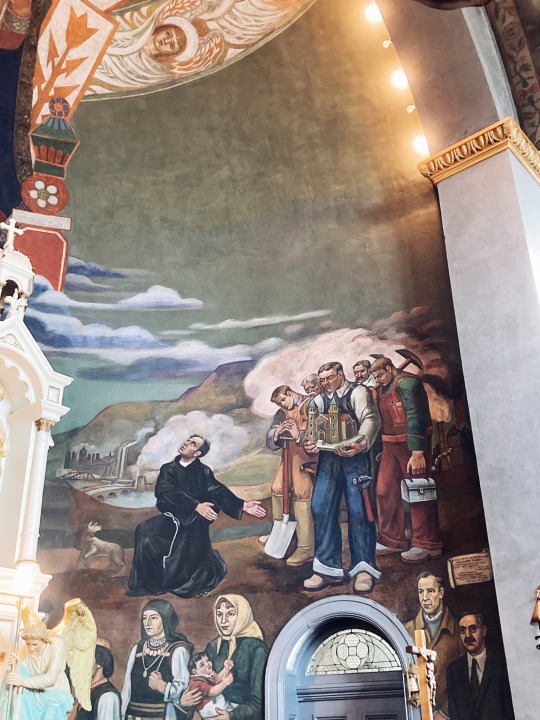
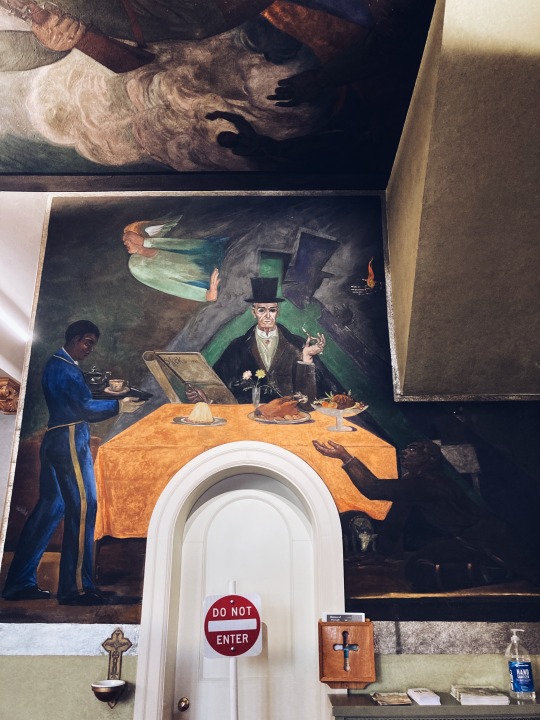
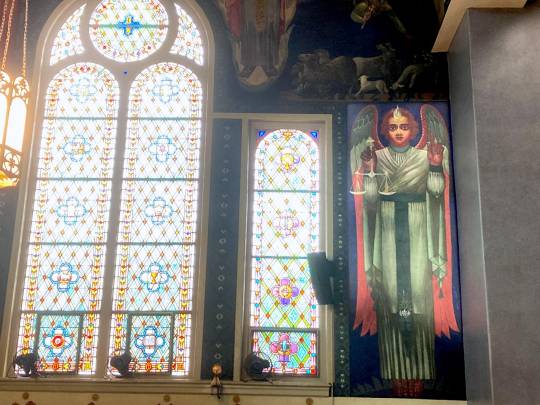
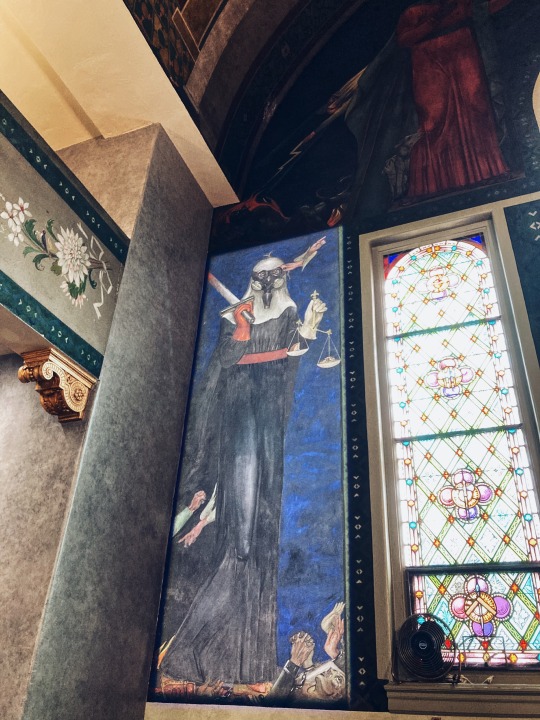
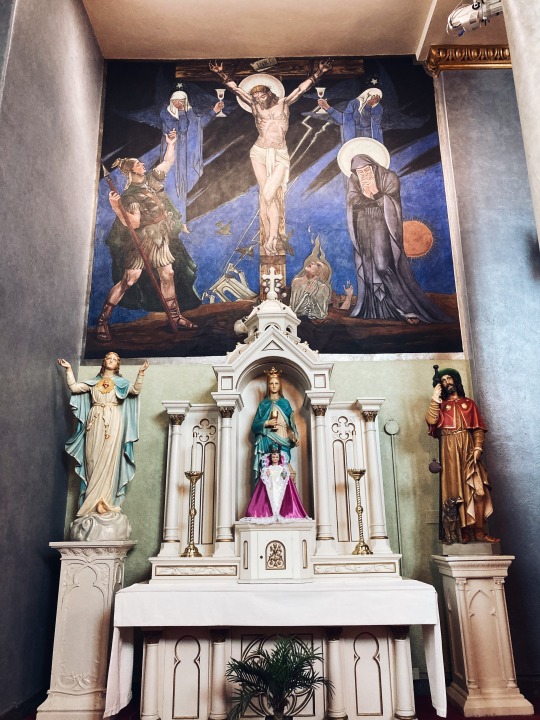
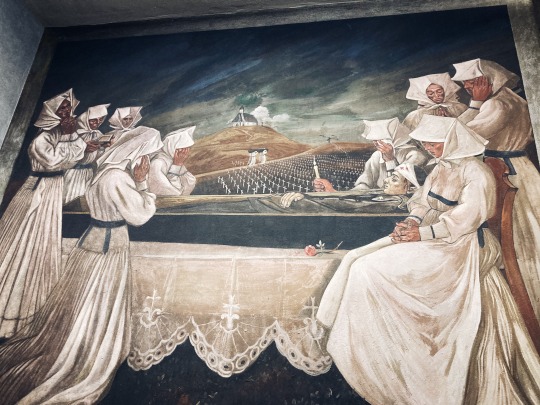
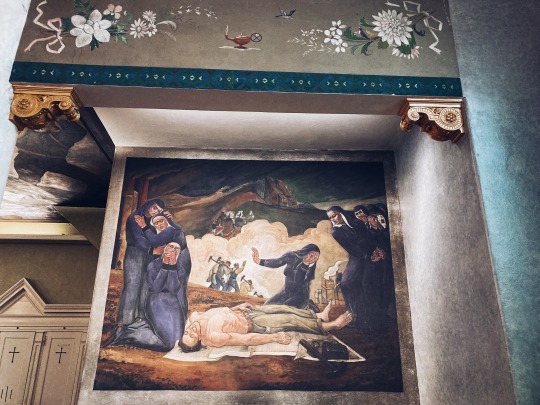
For over a month I have failed miserably to post anything here, proving once again that I can't have good habits. Or at least not yet. Here is something interesting that mostly speaks for itself: a gallery of photographs I took inside Saint Nicholas Croatian Catholic Church in Millave, Pennsylvania (not exactly Pittsburgh, but part of the Diocese of Pittsburgh). These murals were commissioned to Maxo Vanka, a Croatian immigrant artist, in the 1930s. Vanka was the son of aristocrats, though he was born out of wedlock and placed in a peasant home until one of his grandparents found out that he existed and paid for his education in Zagreb. Vanka met Margaret Stetten, a wealthy Jewish New Yorker, while she was doing a tour of Europe; they married and moved back to the US in 1935, as antisemitic sentiment rose. Vanka tried to rebuild his fine arts career and eventually showed work in Pittsburgh, where he caught the eye of the priest of Saint Nicholas. An urban legend (told to me by the friend who took me to this place) says the priest actually dreamt that God ordered to ask Vanka to paint the inside of the church, which was totally white then.
Vanka painted these murals in eight weeks in 1937, which is almost unbelievable. Someone in our guided tour said he was drinking a lot of Coca Cola (apparently it was basically cocaine back then). He returned in 1940 to do the "evil capitalist" one and a couple of others I couldn't photograph very well. The first mural he did was the peasant Virgin Mary, with her broad shoulders and strong hands. Below her Vanka painted two groups: on the left, Croatians in the home country, an idyllic landscape, and dressed in traditional attire; on the right, Croatian immigrants, many of them wearing their work clothes and tools, and one of them holding a miniature model of St. Nicholas itself––a gift of the community to the Virgin. One of the other murals depicts the Crucifixion, and there are portraits of the apostles in the upper walls and ceiling. The vibrant color palette (the royal blue!) and the elongated, expressionist faces and bodies are probably the most immediately arresting elements that stay consistent throughout all the scenes. However, the main attraction here are the anti-war and anti-exploitation murals in which groups of women mourn a fallen soldier in Croatia and a fallen miner in Pittsburgh ("Mothers offer up their sons for war" and "Mothers offer up their sons for labor"). In the first, several women in traditional white funerary dress surround the casket of a dead soldier. In the second, inspired by real events in Pittsburgh, women dressed in black surround the half-naked body of a man––ostensibly the son of one of them––who has died in a mining accident; in the distance we see other workers heading back into the mine to look for survivors. In another wall, a Rockefeller-like figure sits having dinner while ignoring a beggar at the foot of his table. An angel turns their head away in disgust, and a demon extends a bony hand into the scene.
Within the line of sight of churchgoers, so colorful and cinematic, these scenes become part of the wider experience of prayer or worship. I don't recall seeing something like this before. Some scenes (like the evil capitalist with the top hat and the monocle) maybe feel a bit too on-the-nose, but I suppose that's appropriate for the context. In contrast, a couple of these paintings are hermetic in a way that makes you stare. The Angel of Justice, for instance, which is not really "an angel" that we know of by any name (and which mirrors an Angel of Prudence on the wall across, an emblem I love). The ceiling was my favorite parts of the church, painted like literal heaven, in a beautiful blue with lighter patches, stars, and planets. It seems that some of the lighter blues or greenish patches were caused by water damage (because Pittsburgh gets hurricanes, believe it or not), but they actually look beautiful, like nebulae. On the opposite side of Justice is Injustice (again, very didactic), a strangely futuristic-medieval figure wearing a beaked gas mask.
Not a whole lot is known about Vanka's politics, as far as I've been able to search. He's often described simply as a "pacifist." But, of course, these murals clearly express how war disproportionately affects any working class. The tour guide in the church was also unable to tell us if Vanka had had any contact with Mexican muralists, but the timing is perfect and him being in New York for any period of time would make it likely. While these images most likely follow Eastern European mural traditions, to me they have undeniable echoes of José Clemente Orozco --so maybe it was the spirit of the times.
6 notes
·
View notes
Text
Play, reciprocity, and debasement––about The Green Knight (the film, not the poem)
I watched this film twice, and could probably watch it a third time. I loved it because it posed many riddles to me, which I will try to explain here. To summarize the argument very briefly: Gawain, King Arthur's nephew, has never done anything worthy of knighthood. On Christmas Day, a monstrous (and vegetal) Green Knight appears before Arthur's court and challenges someone, anyone, to play a simple game: the challenger must strike the Knight, and a year to the day, would have to meet the Knight in his own abode and receive an equal blow. Gawain jumps at the opportunity to do something heroic and proceeds to behead the Knight without much effort. The Knight collects his head, gets on his horse, and rides away. This turns Gawain into a local celebrity, bringing him the notoriety he never had, but December comes again and he must face part II of the game––in which he loses his head. The film follows Gawain as he reluctantly makes his way to the Green Chapel, encountering road thieves, ghosts of saints, talking foxes, giants, etc.

Maybe because I am not well-versed in Arthurian legends and knightly exploits in general, I found the incredible awkwardness of this story very captivating. First, Gawain is the unlikeliest hero. He isn't very clever or self-confident, and basically does everything wrong, and would do everything wrong up until the very end if not rescued by a vision of the what if and time-traveling/reversal-of-fortune devices. Throughout the film I was not necessarily rooting for him, but of course I wanted to see the absurd, totally gratuitous and murderous "Christmas game" come to its term, so I needed him to get there. Again, I was not rooting for him because I didn't understand him. Why did Gawain volunteer? Was it extreme eagerness, an extremely fragile self-image, dying already for validation? Surely there are things worth dying for, but isn't honor, from my vantage point, mainly fuel for ego––thus, dying for honor implies dying for yourself? This paradox makes all narratives of honor fascinating yet, I feel, stupid. My sense of self is not elevated enough, perhaps. In the film, it appears as though the Green Knight is a spirit summoned by Morgan Le Fay, Arthur's sister and Gawain's mother. Morgan seems very concerned that her son is a nobody in the court, so she ends up producing this strange situation to bring honor to him. Couldn't she just... summon a dragon to slay?
I do understand that the higher the stakes, the greater the praise; the closer and surer Gawain's death, the more his glory. But enough about Gawain. What about the Green Knight? In the film, he is portrayed as a mythological entity of the woodlands––like a Green Man, an ancient figure of rebirth, part human and part foliage. I instantly thought of images of Wild Men too: creatures similar to Green Men, embodiments of primitive man, his basest nature. In the Arthurian legend, the "true" identity of the Knight and his motivations are revealed at the end (turns out it was all a trick!), but the film gives us no such closure. Assuming you don't know the legend, you would be left wondering why this dignified figure would want to enter this agreement. I wonder if there is anything more humiliating than getting your head cut off on purpose. Not only that; the Knight kneels and bares his neck to Gawain to make it easier. So we know Gawain's aspirations when accepting the challenge, but the Knight's reasons to submit to Gawain remain opaque. The sorceress, Morgan, supposedly didn’t create the Knight, she summoned him, so we should assume that he has his own reasons to play the beheading game. Why?

Perhaps the beheading part is not the point, or at least not the whole point. Perhaps the point to really focus on is the reciprocity that this (and most?) game involves. Reciprocity returns over and over in the film: Gawain neglects to reward a boy’s directions, and this sets him up for punishment/“payback”. Gawain beheaded the Knight–– later he is asked to recover the severed head of Saint Winifred. And finally, of course, Gawain arrives in Lord Bertilak’s house and it is agreed that they will gift each other whatever they receive (in the Lord’s case, whatever he hunts) during the days that Gawain is a guest. I thought of two ways to interpret this constant return of reciprocity. One is: social relations are the eternal reproduction of outstanding debt. A very Christian perspective, maybe. But the second take, to me more convincing in terms of how this story unfolds, is: things go well, and move forward, under the sign of generosity. The truth is that Gawain could have gotten away with not showing up at the Green Chapel, and no one would have known. Moreover, King Arthur himself often reminds Gawain that “this is just a game” to calm his nerves. He doesn’t say “you can skip the appointment” though, just that it’s a game. It’s not that a game is not a binding agreement––when you play, you submit to the fiction of the game––but the terms of it are specific. What is most important in the game is not honor, per this film, but generosity toward the other player. Playing a game––especially when you know you’re going to lose! but you keep going––entails acknowledging that the other player’s pleasure depends on you staying in the game. It’s an act of generosity. In contrast to honor, which seems to me a social consensus or a social feeling, generosity is more intimate and frail.
I am sympathetic to the idea that we often owe (in)tangible things to others, and I believe and would always defend the idea that generational or historical debts exist. I remember that somewhere in their book on The Undercommons, Fred Moten and Stefano Harney talk about what those who have nothing owe each other: everything. I do think that “debt” is an appropriate and indisputable term to describe relationships of reciprocity (or where there ought to exist reciprocity) in many contexts. But to understand Gawain’s journey to the Green Chapel as simply fulfilling a debt fuels the honor narrative; the whole quest is transactional––he received only half the honor, now he’s here for the rest. The idea that Gawain goes through all this trouble out of generosity, even if he does not even understand it himself, turns the conventional meaning of the story on its head. The Green Knight’s behavior is weird and obtuse if he’s just a tool in Gawain’s rise to knighthood; but the film, by maintaining the Knight’s identity as an entity with its own motives, preserves the possibility that he just wanted to play. This, to me, is more persuasive. Why a beheading game? Well, why not? If you can just place your head right back on, that is.
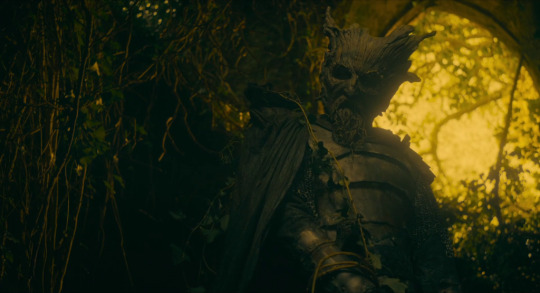
As I was hyping myself up to watch this movie, I came across writings by Daniel Lavery. In one, he look into the erotics of the poem––for instance, this post about the “sexiest lines” is really funny (and, frankly, he has a point; see: That other brave man stood a great while in a study; so stricken was he for grief that he groaned within. All the blood of his breast rushed to his face, and he shrank for shame when the warrior talked…“Let me but please you now, and after I shall beware.”) In a story from his book Sword Stone Table, Lavery writes about chivalry and the purpose of becoming a knight. To summarize: some men become knights to accumulate honor, and some do it “to rid themselves of honor and glory for the love of a true friend.” In the story, Yvan, Gawain and the Queen Guinevere discuss their love for Lancelot and describe how they would debase themselves––or him––for this love. To turn honor to shame. The stakes in this story are higher than in The Green Knight, in a sense, because they are not ruled by a game "contract." But it still resonates, in a way, this idea that generosity involves and even requires the possibility of humiliation. In a game, and in any relationship of love, you have to be willing to be the loser.
Most reviews of this film will say something about Lady Bertilak’s monologue about the green. Obviously, The Green Knight wants to express an ecological critique––the green is everywhere, we fight so hard to contain it and tame it, but it will always return, and we will return to it when we rot. Lady Bertilak seems to suggest that Gawain would be wise to submit to the green (embodied by the knight) because it will get him anyways, some day. It is significant that “the green” breaks into the gloomy and grey court of Arthur on Christmas Day, creating a “crisis” during this particular festivity. But again, what he comes to propose is a game of exchange––very appropriate for Christmas––, to create a contingent balance of wins and losses between the built and the wild, or the Christian and the pagan. And so, while the beheading game does not create a true reconciliation (or mutual annihilation) of opposites, it establishes a bridge that can be crossed with generosity. What I'm left with is a sort of philosophy of play: games are not equivalent to social reality but they are not exactly fiction; they are somewhere in between, in the perfect guarded position to express a wish and rehearse its fulfillment.
1 note
·
View note
Text



Three images of fog in the Ávila, one of my favorite visual themes ever:
1. Claudio Perna (directed photograph, 1967)
2. Carlos Eduardo Puche (from the series Neblinas or Fogs, 1961)
And the third one I took in November, on a day trip to the mountain. I thought about Carlos Puche and his haunting, grainy series many times throughout the day. Puche started his foray into photography in the Universidad Central de Venezuela's School of Science, where he worked with Carlos Herrera in the microphotography lab. Later he led the photo lab in the School of Metallurgical Engineering. In 1961 he shot the Neblinas series and started to employ a more artistic approach to photography; his interest was always in texture and abstraction. Over time his production became more and more conceptual and sculptural (probably due to the influence of his wife, Elsa Gramcko, an abstract sculptor and painter that is much better known than him).
The Claudio Perna image is a directed self-portrait. I don't actually have much information about this picture and I can't find any online. Perna was a geographer and compulsive self-archivist––I can imagine, in some sense, his mind working a little like Puche's, who must have been similarly obsessed with filing and classifying things. I have no idea if they ever met. Perna's work is extremely diverse and difficult to categorize: he did everything––video, performance, photography, printed works. My friend Silvia Benedetti wrote a very good piece about him for MoMA, and I admire her extensive commitment to making Perna graspable, if not fully "intelligible" to us. Silvia argues that Perna was obsessed with the impossibility of documenting an event. And I look at this beautiful photograph––beautiful because it is half-vanishing, because everything about it is spectral––and I know that its beauty is predicated on that impossibility. Neblinas captivate me (and everyone else, since forever) because they enact a concealment phenomenon, an optical and therefore very real erasure that is always reminiscent of something superior to ourselves (with the power to fade us). Unknowable. Perna had himself photographed within the opposite of reliability.
1 note
·
View note
Photo
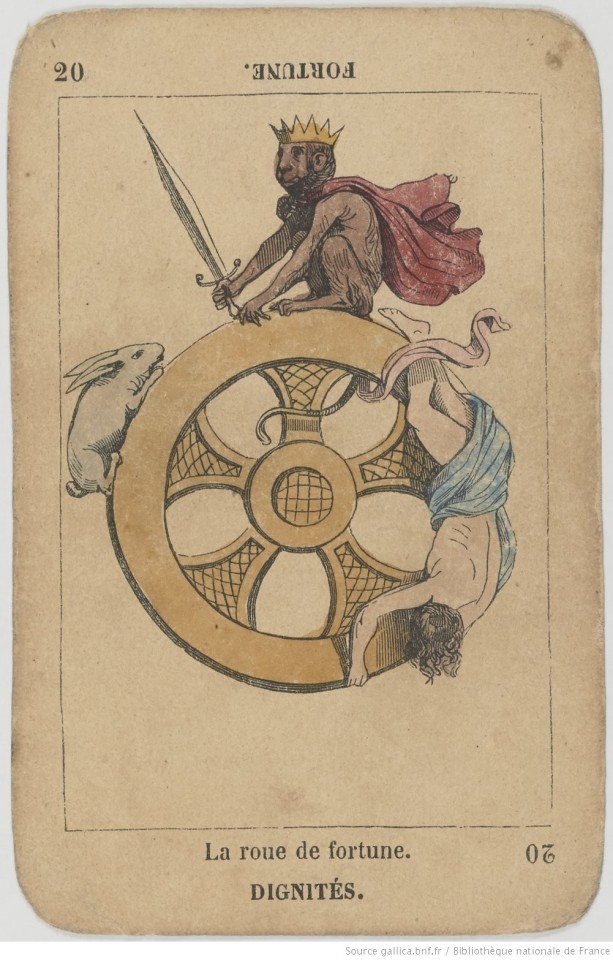
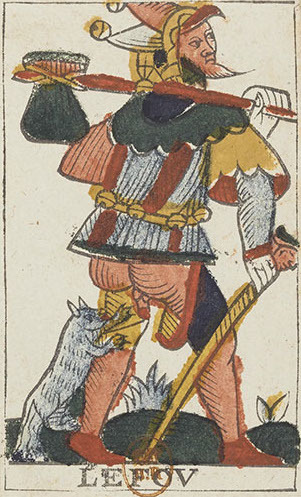
I’m starting this blog on January 1st, 2022, and it will exist until January 1st, 2023. I’ve always wanted to keep a blog, but I’m extraordinarily lazy and can never remember to write without purpose. I fail at all diary-keeping endeavors. In fact, I have three different notettaking apps that I’ve tried to use as diaries, but ultimately just use as notebooks.
A blog isn’t quite as intimate as a diary, but maybe that’s what will help me keep the habit: the fact that I can still, or would still have to retain some of my “mask.” I do find myself often thinking about things somewhere between my personal life and my “professional” life that I have no space for––I hope to just dump them here. Notes, comments, photos, maybe old texts. I’m aware of the benefits of text-dumping.
I’ve always had mixed feelings about January the 1st. For about a decade we would celebrate it collectively with a huge breakfast, and the rest of the day would always pass way too slowly and I remember feeling very impatient and annoyed. I would always want the afternoon to be over quickly and just get on with it, let’s just move on into the year. These days I regard the date differently––with more attention. In some traditions, like the “cabañuelas” popular in the Caribbean and Spain, today marks the beginning of the “omen days”; in other places they start on December 26th, the same time as the 12 days of Christmas. Regardless of the tradition, the first week of January is full of information about what will come, what the weather (meteorological and, I guess, affective) will be like each month. From the days you distill a general sense of the year. So I ask, what are the signs so far? A wasp, a fly, a cloudy sky, a steaming cup of coffee, a slight headache, the smell of nutmeg, a noisy flock of birds, a blue-lilac dusk. There is a day’s full of omens to watch out for.... Starting a blog on January 1st! I hope to have created an omen for myself: you will write and enjoy writing. You will find a new mode of writing, a mindset that is more calm and maybe, at the same time, more joyful. You will find a better way to join together all the parts of yourself that seem incongruous.
I end this post with a comment about the above images of the tarot. The Wheel is one of my favorite Major Arcana, because when it appears in a reading it produces a ‘reckoning.’ Are you (is “the querent”) at the top or at the bottom of the wheel? Does it matter? What matters is that if you are up you will come down, and if you are down you will go up. The “Rota Fortunae” is and has always been spinning. I can see how this concept could be unnerving, but I am convinced that it is profoundly comforting deep down. If historically the allegory of the Wheel had been employed to emphasize the transitoriness and capriciousness of earthly events, it serves a similar purpose in the tarot. After all, if we ask a deck of cards for advice, it is usually because we strongly desire or fear some sort of disruption. The Wheel tells us that we can’t hold off fate, but we can trust that nothing stays the same forever, and whatever is permanent about existence will not be destroyed by one more turn. All in all, the implications of the Wheel (impermanence, the only constant is change) used to make me nervous, but now they soothe me... perhaps because I never feel very stable myself. And so after the wheel has done its December Turn, we find ourselves in January, like the Fool, full of desire and formless energy. Formlessness can be frightening, but on January 1st, it’s liberating: the path to still travel, the year yet to be shaped––by our own will, instincts, and emotions, as much as by the whims of fortune.
I guess this is how, officially, this exercise in self-destructing writing begins. Happy new year.
Images: The Wheel of Fortune is from the “Jeu de tarot de fantaisie ‘égyptien’ á enseignes italiennes, dit ‘Grand Etteilla’” (c. 1850-ish), and the Fool is from the Jean Noblet Tarot (c. 1650). Etteilla was a French occultist whose system I’m very interested in learning but... I’m still trying to fully absorb the Marseille tradition. Maybe this year.
1 note
·
View note
